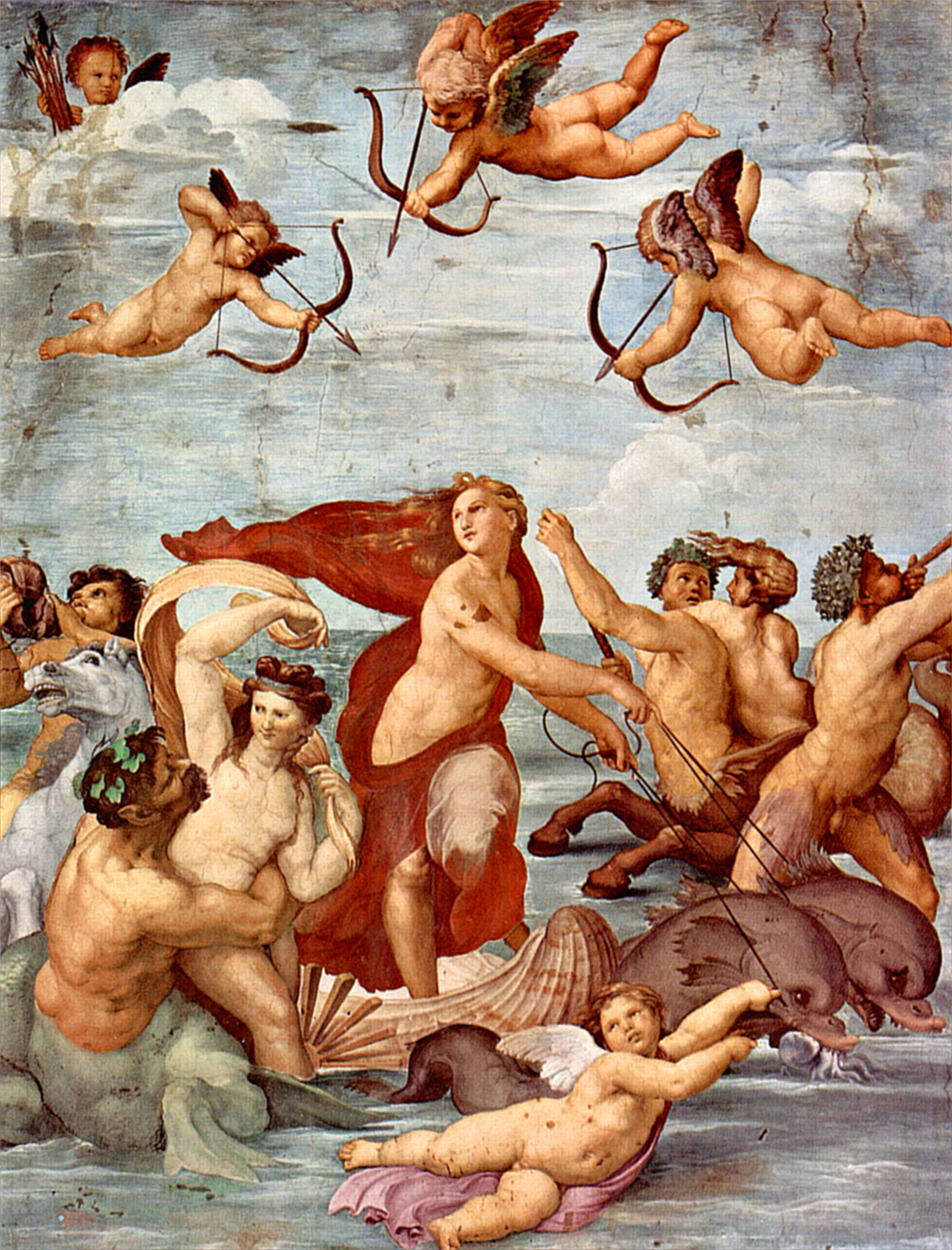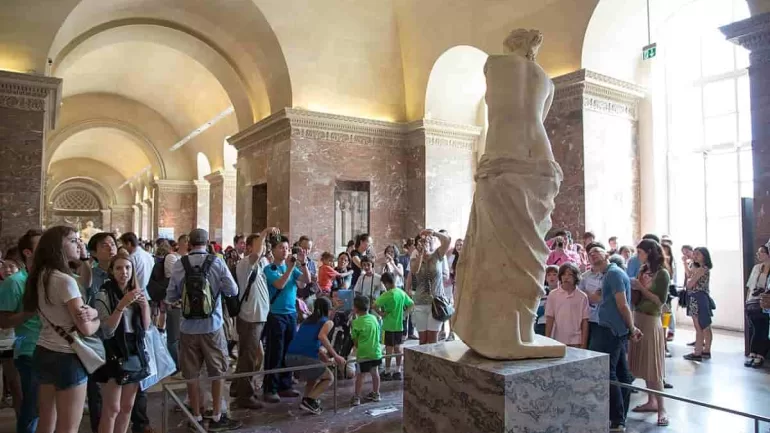ART
A crowd gathers in front of the sculpture of Aphrodite, Venus de Milo, at the Louvre. This symbol of love and beauty is an important example of ways artists were exploring the beauty of love in art in ancient Greece. Photo: Victor Grigas. Via Wikimedia CCA 4.0
Through tender, romantic gestures or powerful, dramatic portrayals, artists exploring the beauty of love in art invite us to reflect on our relationships, desires, and the impact love has on our lives.
BY KAZEEM ADELEKE, ARTCENTRON
Art has always been a medium through which human emotions are conveyed, and one of the most prominent themes throughout art history is love. From the gentle caress of Venus in Botticelli’s The Birth of Venus to the passionate embrace in Gustav Klimt’s The Kiss, exploring the beauty of love in art offers a glimpse into how love has shaped culture, inspired creativity, and touched the hearts of viewers for centuries. This is an exploration of how love appears in art. It examines key works, the artists, and analyzes the emotional impact of these timeless masterpieces.
The Significance of Love in Art
Love is a universal emotion that transcends time, culture, and geography. Its representation in art has been crucial in conveying human experiences and connecting with audiences. Through love, artists have been able to explore themes of passion, longing, heartache, and devotion. Whether in the form of romantic love, familial love, or divine love, art is a powerful tool. It helps communicate the many facets of this complex emotion.
The depiction of love in art also reflects the societal values and beliefs of different periods. In antiquity, love was often portrayed as an idealized, divine force—whether in Greco-Roman mythology or early Christian symbolism. The Renaissance period brought about a renewed focus on humanism. This was when artists began to explore more intimate, personal aspects of love. Meanwhile, the Romantic era examined the emotional and dramatic aspects of love, capturing its intensity and unpredictability.
Ancient Representations of Love
The concept of love in ancient art was deeply intertwined with mythology and religion. In ancient Greece and Rome, love was often personified by deities, with Aphrodite (Venus in Roman mythology) being the goddess of love, beauty, and desire. Numerous artworks from this period depict her as an idealized figure of sensual beauty. Artists often use her as a symbol of the perfect union of beauty and love.
One of the most famous depictions of Venus is in the Venus de Milo, a marble statue created during the Hellenistic period. Though the statue lacks arms, it captures the idealized beauty of the goddess in a stance that suggests grace and elegance. The image of Venus has remained a symbol of love and beauty throughout the centuries.
In addition to depictions of deities, ancient love was also explored through depictions of love between mortals. Greek vase paintings often illustrated mythological scenes involving love. Famous examples include the abduction of Persephone by Hades or the love story of Orpheus and Eurydice. These stories were not merely about romantic affection but also an exploration of the deeper, sometimes tragic, consequences of love.
Love in the Renaissance: A New Humanism
During the Renaissance, the portrayal of love became more human-centered. Artists began to focus on the intimate relationships between individuals, often using classical mythology as a foundation. One of the most iconic works that exemplifies this shift is Sandro Botticelli’s The Birth of Venus (1486). In this painting, Venus emerges from the sea, symbolizing both divine beauty and the transformative power of love. The ethereal beauty of Venus appears in soft, flowing lines that suggest grace and purity. These elements represent idealized love as both celestial and earthly.
Leonardo da Vinci’s The Last Supper (1495-1498) also explores love, though in a more complex and spiritual way. The love between Christ and his disciples is portrayed through their gestures and expressions. This work highlights the deep bond between Christ and his followers, a bond rooted in sacrifice, loyalty, and faith. The love depicted here is divine, transcending human limitations.
Another notable Renaissance painting is Raphael’s The Triumph of Galatea (1512). This fresco showcases the story of Galatea, a sea nymph in love with the mortal Acis, set within a lush, idealized landscape. Raphael’s use of color and light imbues the scene with a sense of joy and celebration, reflecting the harmonious and enduring nature of love.
Exploring the Beauty of Love in Art with Timeless Masterpieces

The Baroque Era: Dramatic Passion
In the Baroque period (17th century), love was often depicted with intense emotion and dramatic flair. Artists of this time embraced the use of strong contrasts between light and dark (chiaroscuro) to heighten the emotional tension in their works. One such example is Caravaggio’s Amor Vincit Omnia (1602), where the figure of Cupid holds a bow and arrow while standing triumphantly over the vanquished symbols of war and pride. The painting emphasizes the overpowering force of love and its ability to conquer all obstacles.
Another well-known Baroque artist, Peter Paul Rubens, frequently depicted sensual love in his paintings. In works like The Three Graces (1635), Rubens presents a trio of women embracing each other in a harmonious, flowing composition. The painting emphasizes the physical beauty of the female form. However, the closeness of the figures suggests a deeper emotional connection between them.
Baroque art also saw a greater exploration of religious love, particularly in the works of artists like Gian Lorenzo Bernini. His The Ecstasy of Saint Teresa (1647-1652), a marble sculpture, captures a moment of divine love as the saint is depicted in a state of spiritual rapture. The work conveys the intensity of spiritual longing. Using dramatic light and movement, the work evokes a profound emotional response from the viewer.
Romanticism: Passion and Emotion
The 19th century ushered in the Romantic movement, a period defined by its emphasis on emotional depth, individualism, and the sublime. Romantic artists sought to capture the intense and often tumultuous nature of love, frequently portraying it in ways that were dramatic and emotive.
One of the key works of Romantic art that explores love is Eugène Delacroix’s The Death of Sardanapalus (1827). Though not a traditional love story, the painting captures the destructive power of love and desire. The painting depicts the legendary Assyrian king Sardanapalus, who, upon hearing of his impending defeat, orders the destruction of his possessions and the death of his concubines. Delacroix’s use of vivid color and dramatic movement conveys the chaos and tragedy of love taken to its extreme.
Another Romantic masterpiece is Gustave Courbet’s The Origin of the World (1866). This groundbreaking painting explores the theme of sensuality and the female body as a symbol of erotic love. The work challenges traditional representations of love and nudity, embracing a more direct and unapologetic exploration of physical intimacy.
One of the most iconic representations of romantic love in art comes from Gustav Klimt’s The Kiss (1907-1908). It was created during the fin de siècle period. This golden, ethereal masterpiece captures a couple locked in a passionate embrace. The lavish use of gold leaf and ornamental patterns gives the painting a dreamlike quality. It highlights the sensuality and spiritual connection between the lovers. The Kiss has come to symbolize the ultimate expression of love—both tender and passionate, physical and emotional.
Modern and Contemporary Perspectives on Love
As art continued to evolve into the 20th century, the representation of love became more abstract, experimental, and varied. Modernist artists such as Pablo Picasso and Marc Chagall challenged traditional notions of love, exploring them in ways that reflected the changing dynamics of the time. Picasso’s Weeping Woman (1937), for instance, depicts a woman in grief, yet her expression is a reflection of the pain that often accompanies love’s fragility.
Chagall’s works, such as The Lovers (1913), explore surrealist depictions of love. It blurs the boundaries between reality and fantasy. In this piece, a couple floats above a vibrant landscape, their bodies entwined in an ethereal embrace, symbolizing the boundless nature of love and the transcendence it can provide.
Contemporary artists continue to explore the theme of love in their work, often addressing complex societal and personal issues. Artists like Tracey Emin and Jeff Koons have pushed the boundaries of how love appears in contemporary art. Emin’s My Bed (1998), for example, incorporates the artist’s experiences of love, loss, and emotional turmoil. Koons, on the other hand, often uses kitsch and pop culture references to explore the commercialization of love and desire, as seen in his Balloon Dog sculptures.

The Emotional Impact of Love in Art
The beauty of love in art lies not just in the visual representation of affection but also in its ability to evoke deep emotions in the viewer. Whether it is the serene, idealized beauty of a Renaissance portrait or the passionate intensity of a Romantic masterpiece, art has the power to make us feel love’s joy, longing, pain, and loss.
When we encounter works that explore love, they rekindle our own experiences and relationships. The universality of love allows these works to speak across time and space. It helps foster a sense of connection between the artist and the viewer. Above all, It is through this emotional resonance that the beauty of love in art continues to captivate us.
Exploring the Beauty of Love in Art Through History
Exploring the beauty of love in art offers an enriching journey through history, from the idealized figures of ancient mythology to the emotional depth of contemporary works. Love has been portrayed in countless ways, but it remains one of the most enduring and universal themes in the art world. As we engage with these masterpieces, we not only appreciate their technical skill but also their beauty. Additionally, we can connect with the timeless emotions they represent. Love, in all its forms, continues to inspire artists and viewers alike. This makes it a central and eternal theme in the world of art.
Whether through tender, romantic gestures or powerful, dramatic portrayals, art’s exploration of love invites us to reflect on our relationships and desires. It allows us to examine the profound impact love has on our lives. As we continue to explore the beauty of love in art, its ability to transcend the limitations of time and culture comes forth. This makes it a truly timeless and universal subject.
